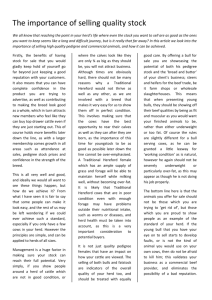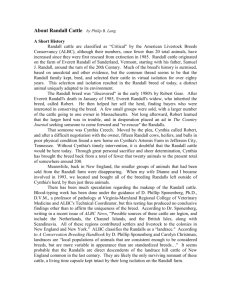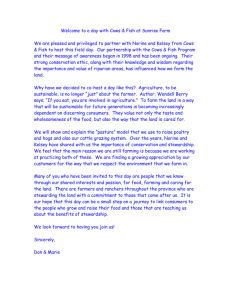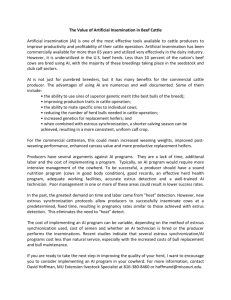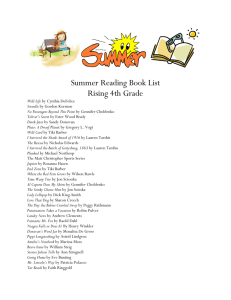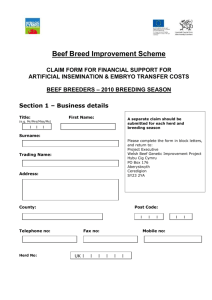South Kent is the Randall capital of the world
advertisement
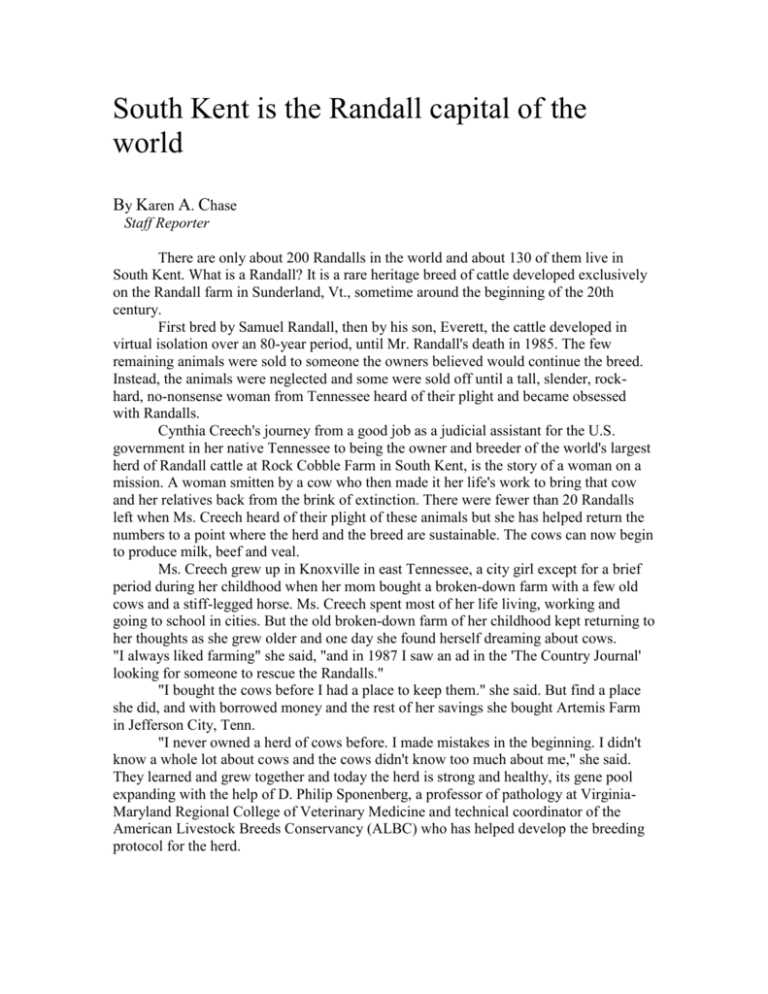
South Kent is the Randall capital of the world By Karen A. Chase Staff Reporter There are only about 200 Randalls in the world and about 130 of them live in South Kent. What is a Randall? It is a rare heritage breed of cattle developed exclusively on the Randall farm in Sunderland, Vt., sometime around the beginning of the 20th century. First bred by Samuel Randall, then by his son, Everett, the cattle developed in virtual isolation over an 80-year period, until Mr. Randall's death in 1985. The few remaining animals were sold to someone the owners believed would continue the breed. Instead, the animals were neglected and some were sold off until a tall, slender, rockhard, no-nonsense woman from Tennessee heard of their plight and became obsessed with Randalls. Cynthia Creech's journey from a good job as a judicial assistant for the U.S. government in her native Tennessee to being the owner and breeder of the world's largest herd of Randall cattle at Rock Cobble Farm in South Kent, is the story of a woman on a mission. A woman smitten by a cow who then made it her life's work to bring that cow and her relatives back from the brink of extinction. There were fewer than 20 Randalls left when Ms. Creech heard of their plight of these animals but she has helped return the numbers to a point where the herd and the breed are sustainable. The cows can now begin to produce milk, beef and veal. Ms. Creech grew up in Knoxville in east Tennessee, a city girl except for a brief period during her childhood when her mom bought a broken-down farm with a few old cows and a stiff-legged horse. Ms. Creech spent most of her life living, working and going to school in cities. But the old broken-down farm of her childhood kept returning to her thoughts as she grew older and one day she found herself dreaming about cows. "I always liked farming" she said, "and in 1987 I saw an ad in the 'The Country Journal' looking for someone to rescue the Randalls." "I bought the cows before I had a place to keep them." she said. But find a place she did, and with borrowed money and the rest of her savings she bought Artemis Farm in Jefferson City, Tenn. "I never owned a herd of cows before. I made mistakes in the beginning. I didn't know a whole lot about cows and the cows didn't know too much about me," she said. They learned and grew together and today the herd is strong and healthy, its gene pool expanding with the help of D. Philip Sponenberg, a professor of pathology at VirginiaMaryland Regional College of Veterinary Medicine and technical coordinator of the American Livestock Breeds Conservancy (ALBC) who has helped develop the breeding protocol for the herd. What became apparent early on with Randalls is that they were not suited for the warmer, more humid climate of Tennessee and so began Ms. Creech's next journey, to bring the Randalls back to their native New England. About the time Ms. Creech was looking to move north a Texan was moving east. Ann Bass began purchasing land in the South Kent section of Kent, purchasing several farms on Peet and Ore Hills. She combined the large tracts of land and began to realize a dream she had of turning the land back as closely as possible to its roots in the 18th and 19th centuries. Buildings were torn down or rebuilt, depending upon how they fit into the restoration project. Stonewalls were constructed and wire fences removed, barns were reclaimed, stripping off the years and revealing timber-framed structures of hand-hewn beams and wooden-pegged joints-works of the carpenter's art. Non-native and invasive plants were being removed and native plantings restored, one house on the property was restored to its early splendor and one is being preserved as a promise to the former owner, Carolyn Chase, and because of its close connection to local history. During a visit to Hancock Shaker Village, Ms. Bass was introduced to heritage breeds and the concept of conserving the rapidly disappearing variations of cattle, and other farm animals upon which our ancestors relied for their existence. Ms. Bass determined that she wanted to be part of the conservation effort and that fit perfectly with what she was trying to accomplish with the restoration efforts at her Rock Cobble Farm. Also around the same time, Phil and Dianne Lang, owners of Howland Homestead, located on Geer Mountain on the opposite side of South Kent from Rock Cobble Farm, also became interested in Randall cattle and located and purchased the three remaining animals outside of those owned by Ms. Creech. Meanwhile, Ms. Creech was slowly making her way northward, having left the farm in Tennessee for a position as herdsman on a farm in northern Virginia. The move proved to be a bad choice for her and her small herd of Randalls and she was looking for a new place when she heard about a possible position on a farm in Connecticut. Numerous letters and serious negotiations ensued before two very different women from different backgrounds- but with a similar dream- struck a deal. The Randalls were moved to South Kent to take up residence and populate the pastures once occupied by the hardy hill cattle of an earlier time; cattle from which the Randall is very likely closely descended. "Randalls," according to Ms. Creech, "are a medium-size animal with curved horns and a distinctive black to bluish mottled coloring on a white background." The main characteristics of the breed are that "they are tough, resilient and have lost none of their 'cowness.'" "An all-purpose animal, Randalls have two distinct types within the breed;" Ms. Creech explained, "a lighter more refined 'dairy' type, somewhat similar in structure to a Jersey cow, and a squarer, more beefy, type that lends itself more to meat production, although both types can be used for either purpose. "Randalls are not the big milk producers found on today's modern dairy farm where," she continued. "Cows like the Holstein have been bred for heavy milk production and can produce 80 to100 pounds of milk a day. Randalls are more suited for sustainable, family or small farming type agriculture and produce in the neighborhood of 30 pounds of milk per day." "The big difference" she said, "is that Randalls produce milk on grass. They don't need specialized feed and they live and produce milk well into their 20’s. They have very few health problems and I feed almost no grain" she continued, "They have a feral nature and coyotes don't mess with these cows. They chase the coyotes." According to Ms. Creech, "Randalls are good mothers and gentle if handled early on. They have few parasite problems and require very little in the way of care. They will even eat nuts and acorns." Ms. Creech and the Langs have developed their herds, with the Langs having expanded theirs from the original three cows to a herd of about 30. Ms. Creech has carefully bred her 20 cows and bulls to bring the numbers to up more than 100 and there are now about 15 other farms with small herds of five to 10 animals. Because of Ms. Creech's dedication and the assistance of the Langs and Ms. Bass the Randalls are a success story. There are now more than 200 Randalls in the country and their continued existence is, at present, assured. Ms. Bass and Ms. Creech are committed to keeping the breed alive, healthy and viable with plans to make them sustainable through sale of organic beef and rose veal products. There are plans to build a small dairy for organic milk production sometime in the near future. With about 130 Randall cattle dotting the mountain pastures of South Kent, on both the east and west hills, on farms that have turned back the clock to a less "modern" style of agriculture, the Randalls have returned to their New England roots; and South Kent is truly the Randall Cattle capital of the world. It is also the home of the official Randall Cattle Breed registry., The Randall Cattle Registry, Inc. ‘They are tough, resilient, and have lost none of their “cowness’” ---CYNTHIA CREECH, RANDALL BREEDER

